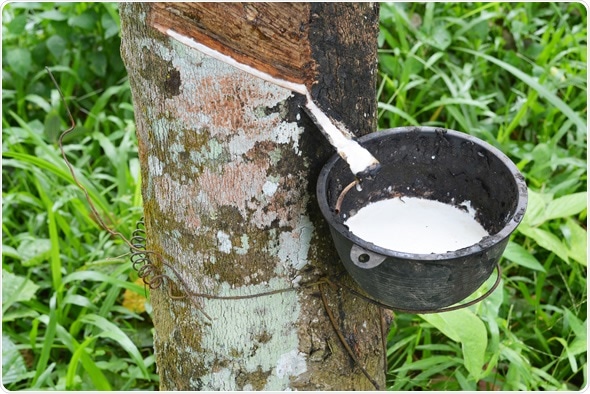Natural rubber latex (NRL) is a milky sap acquired from the Hevea brasiliensis tree, a rubber tree of the Euphorbiaceae family (spurge family) grown in south-east Asia and other countries. During manufacture, NRL is mixed with chemicals to give latex its identifiable elastic properties.
NRL is found in thousands of healthcare items and consumer products such as condoms, rubber bands, gloves, erasers, toys and balloons. It has been widely used in the production of surgical gloves or examination gloves and in the manufacture of a wide range of medical devices.

Cause of Latex Allergy
NRL contains certain proteins that susceptible individuals can develop an allergy to because the body mistakes them for allergens. The immune system triggers the production of antibodies, which then fight the allergen. The next time a person is exposed to NRL, those antibodies instruct the release of histamine and other chemicals that produce the signs and symptoms of allergy. The more frequent the exposure to NRL, the more likely the immune system is to generate a strong reaction to it – this is referred to as sensitization.
Latex allergy is therefore most common in people who are regularly exposed to NRL products such as people working in healthcare, catering or hairdressing, but also individuals who have had multiple surgeries. The research has shown that 65% of children with spina bifida (a serious birth defect that results in the incomplete development of the spinal cord or its coverings) are sensitized to NRL.
The NRL proteins can trigger conditions such as dermatitis and asthma and, although rare, a more serious allergic reaction called anaphylaxis can also develop. The proteins may trigger an allergic reaction either through direct skin contact (which is the most common path) or through inhalation of the powder present on powdered latex gloves. The amount of NRL particles present on a glove varies widely between the different brands available on the market.
Nevertheless, it must be emphasized that not all latex products contain NRL, and items that contain synthetic latex (such as latex paint) are not likely to trigger an allergic reaction.
Symptoms
A mild latex allergy may induce symptoms such as hives, itching, scaling and redness of the skin. More severe symptoms include breathing difficulties, itchy throat, coughing and wheezing. The most severe form of allergic reaction is anaphylactic shock, which can be life threatening. This reaction develops immediately after exposure to NRL with signs and symptoms that include the following:
- Difficulty breathing
- Nausea and vomiting
- A fall in blood pressure
- Confusion
- Loss of consciousness
- Dizziness
- Weak or rapid pulse
- Stomach cramping
- Difficulty swallowing
- Hoarse voice
- Diarrhea
- Tight chest
- Swollen throat or swelling other body areas
- Pale or red facial color
Diagnosis
If an immunologist or allergist suspects a person may have a latex allergy, they will usually ask about the person’s health history and then perform tests to determine whether they have an allergy. They may recommend a skin test, where small amounts of NRL are placed on the back or forearm and the skin pricked with a tiny needle to allow the substance underneath the skin. If the patient is allergic, they will develop a small raised bump at the site of exposure.
A blood test may also be recommended and the sample tested in a laboratory to determine whether there is sensitivity to latex. Nevertheless, when applying this method to confirm a clinical diagnosis of latex allergy, it must be noted that one of every four patients may exhibit a false negative serology test.
Treatment and Management
Although drugs are available to reduce the symptoms of latex allergy, there is no cure available. The only way to prevent an allergic reaction is to avoid exposure to NRL. A new form of NRL is now available that is obtained from a desert plant called guayale, which is thought to be a safer alternative for people working in healthcare and those with a latex allergy. Other synthetic substitutes for latex gloves such as nitrile or vinyl gloves are also considered safe and should be used by any person with a confirmed latex allergy.
Some examples of latex-containing products that should be avoided include:
- Dishwashing gloves
- Balloons
- Erasers
- Rubber toys
- Rubber bands
- Swimming goggles
- Hot water bottles
- Baby bottle nipples
- Condoms
- Diaphragms
- Blood pressure cuffs
- Stethoscopes
- Electrode pads
- Syringes
- Respirators
- Intravenous tubing
- Surgical masks
However, despite efforts to avoid exposure, contact with NRL may still accidentally occur and if a person has previously had a severe reaction, they may need to carry epinephrine on them at all times. If they do experience anaphylactic shock, they will require an emergency injection of this epinephrine, which is the only medication that can reverse the symptoms of the reaction.
If a person experiences less severe allergic reactions, their doctor may prescribe antihistamines, which they can take after exposure, to minimize the reaction and relieve symptoms. Localized contact dermatitis can be treated with topical corticosteroids.

0Comments